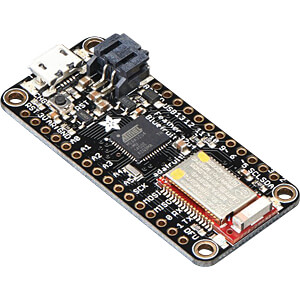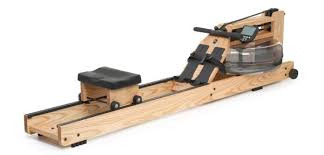WaterRower S4 BLE Arduino SAMD21 BLE
The aim of this project is to interface your WaterRower with an App or with your Garmin Watch. the way to do it is to build a small & efficient BLE Module for the S4 WaterRower Monitor providing a Bluetooth Low Energy module.
IOS / Android Exemple app Water Rower Connect https://apps.apple.com/fr/app/waterrower-connect/id1463763094
The WaterRower is a really cool and beautifull Rower with a S4 Controller. This controller has a USB port at the back and we can use it to create a USB to BLE (Bluetooth Low Energy Bridge).
The WaterRower S4 Controller use USB CDC ACM protocol. This means that UART Over USB will not work, a device with USB Host and Virtual Serial is needed.
A device with BLE (Bluetooth Low Energy) and Native USB port capabilities is needed. ESP32 will not work as it has no Native USB Port.
SAMD MicroController can do USB CDC ACM, and the Adafruit Feather M0 Bluefruit LE is a One-In-All approach:
- ATSAMD21G18 ARM Cortex M0 processor
- nRF51822 chipset from Nordic as Bluetooth stack
- Built in battery charging, this will be very usefull to avoid heavy external power supply
https://www.adafruit.com/product/2995
It is also a quite competitive product $29.95
As per the BLE GATT specification, The Fitness Machine Service implement the Rower Data Characteristics https://www.bluetooth.com/specifications/gatt/
Fitness Service UID is 0x1826 RowerData Characteristics UID is 0x2AD1
- Bitfield data : define which field is present
- Datafield : datafield
// 0000000000001 - 1 - 0x001 - More Data 0
// 0000000000010 - 2 - 0x002 - Average Stroke present
// 0000000000100 - 4 - 0x004 - Total Distance Present
// 0000000001000 - 8 - 0x008 - Instantaneous Pace present
// 0000000010000 - 16 - 0x010 - Average Pace Present
// 0000000100000 - 32 - 0x020 - Instantaneous Power present
// 0000001000000 - 64 - 0x040 - Average Power present
// 0000010000000 - 128 - 0x080 - Resistance Level present
// 0000100000000 - 256 - 0x080 - Expended Energy present
// 0001000000000 - 512 - 0x080 - Heart Rate present
// 0010000000000 - 1024- 0x080 - Metabolic Equivalent present
// 0100000000000 - 2048- 0x080 - Elapsed Time present
// 1000000000000 - 4096- 0x080 - Remaining Time present
`
Warning 1 <!> the first item is working the opposite way : 0 field are present, 1 field are not present
// C1 Stroke Rate uint8 Position 2 (After the ByteField 2 bytes)
// C1 Stroke Count uint16 Position 3
// C2 Average Stroke Rate uint8 Position 5
// C3 Total Distance uint24 Position 6
// C4 Instantaneous Pace uint16 Position 9
// C5 Average Pace uint16 Position 11
// C6 Instantaneous Power sint16 Position 13
// C7 Average Power sint16 Position 15
// C8 Resistance Level sint16 Position 17
// C9 Total Energy uint16 Position 19
// C9 Energy Per Hour uint16 Position 21
// C9 Energy Per Minute uint8 Position 23
// C10 Heart Rate uint8 Position 24
// C11 Metabolic Equivalent uint8 Position 25
// C12 Elapsed Time uint16 Position 26
// C13 Remaining Time uint16 Position 28
Warning 2 <!> the Nordic BLE module is able to manage 30 Bytes message including header meaning 20 Bytes.
If you need all the fields, then the BLE message will have to be splitted in 2 sub message.
As mentionned above, the S4 Controller is able to manage only Native USB Host with CDC ACM Protocol. Thus, the Adafruit M0 needs to use and specific library for SAMD21/51 Microchip. Hopefully: GDsports has done a portage to SAMD from the library is based on the USB Host Shield Library 2.0
https://github.com/gdsports/USB_Host_Library_SAMD
Looking also at the specification (Water Rower S4 S5 USB Protocol Iss 1 04.pdf), the S4 uses CDC ACM with :
- 115200 bps, way to fast for th SAMD21, max handled is 57600 bps
- Message has to be sent char y char every 25ms
- Make sure to clear the socket input buffer (only 64 bytes on CDC Host implementation), before sending command
Do not use delay() as it is a blocking function and it will flood the input USB Serial buffer.
The USB Stack is ready after 32 loop iteration (see code).
A Reset is done at the beginning of the program. Normally the WaterRower should bip.
A conditon has also been set to request S4 Memory Data only when the BLE App is connected.
The current version starts to work, but there is a lot of work to be done.
To debug this App while connected to the S4, I use a serial port on pin RX/TX +GND with an ESP32 receiving the Data and acting as a UART to USB Bridge.
Todo :
- Change BLE message format to only focus on : strokeCount, StrokeRate, totalDistance, InstaneousPower. Remove everything else
- Optimize startup time
- Do testing to finetune ACM port Management.
- Add a Poly Battery, Print a 3D case,
- Create a Garmin Custom Field
I hope my code will help you, I was looking for such implementation with no luck and needless to say that It was a P..n in the A.s to make this stuf works.
Vincent

